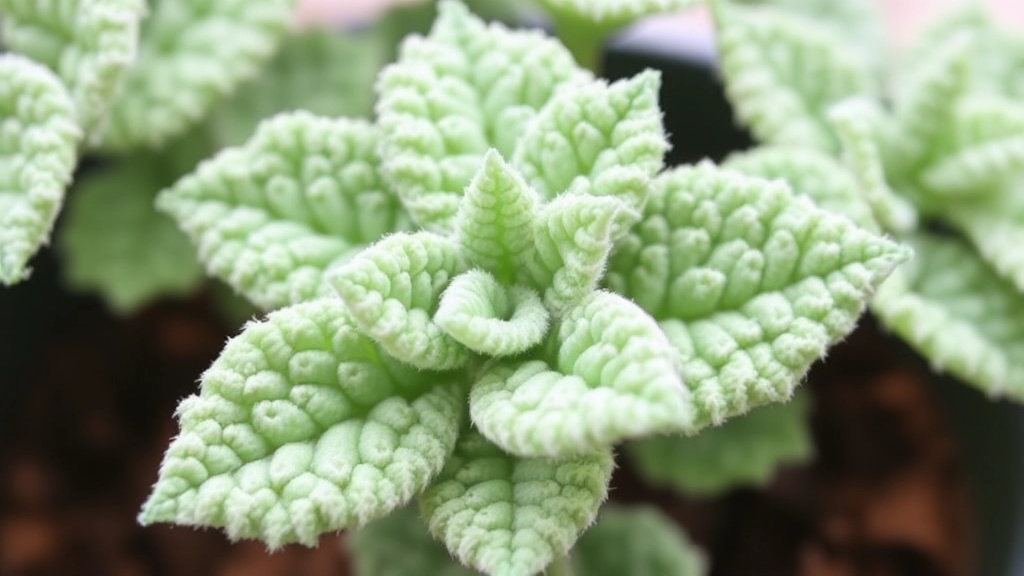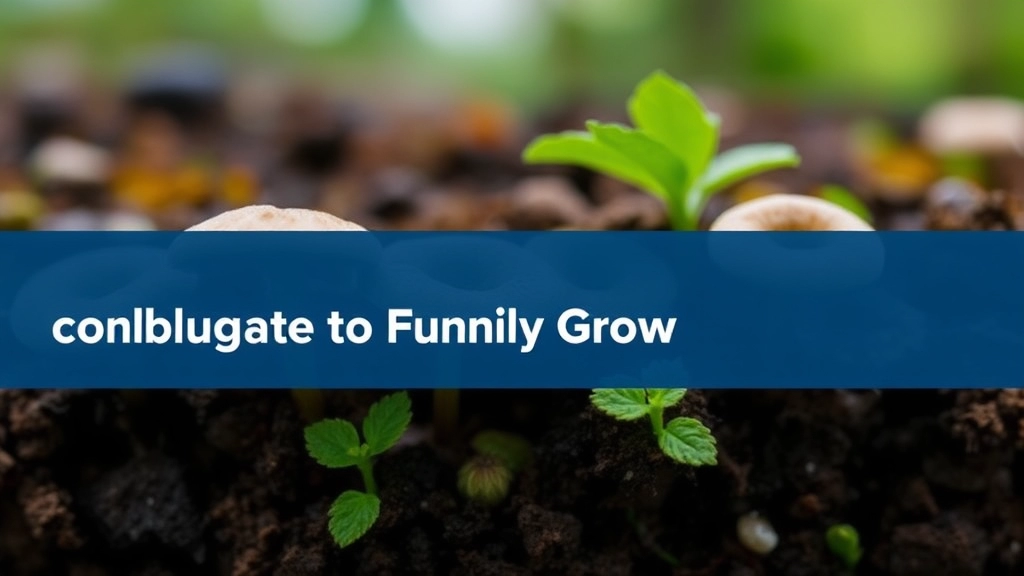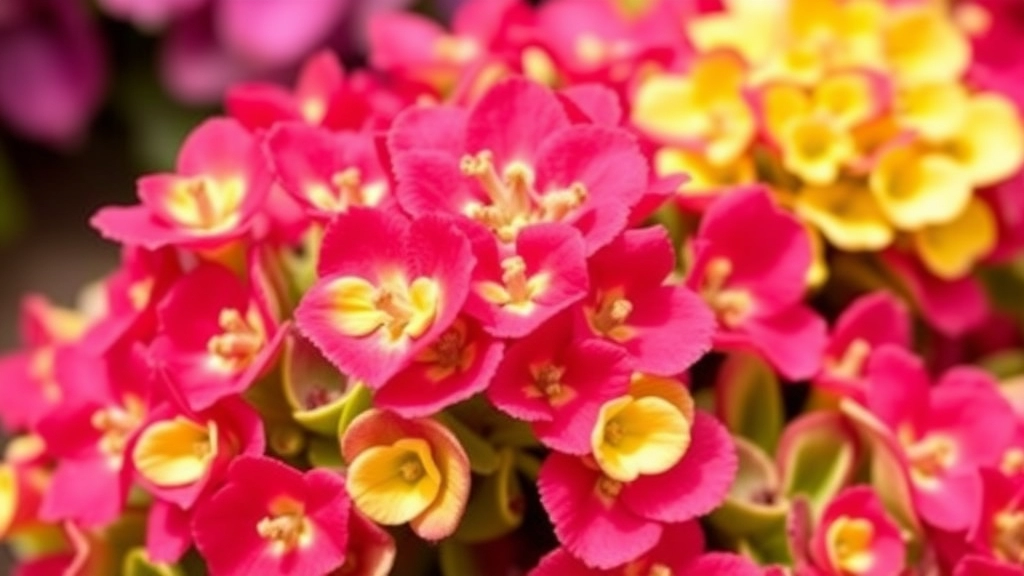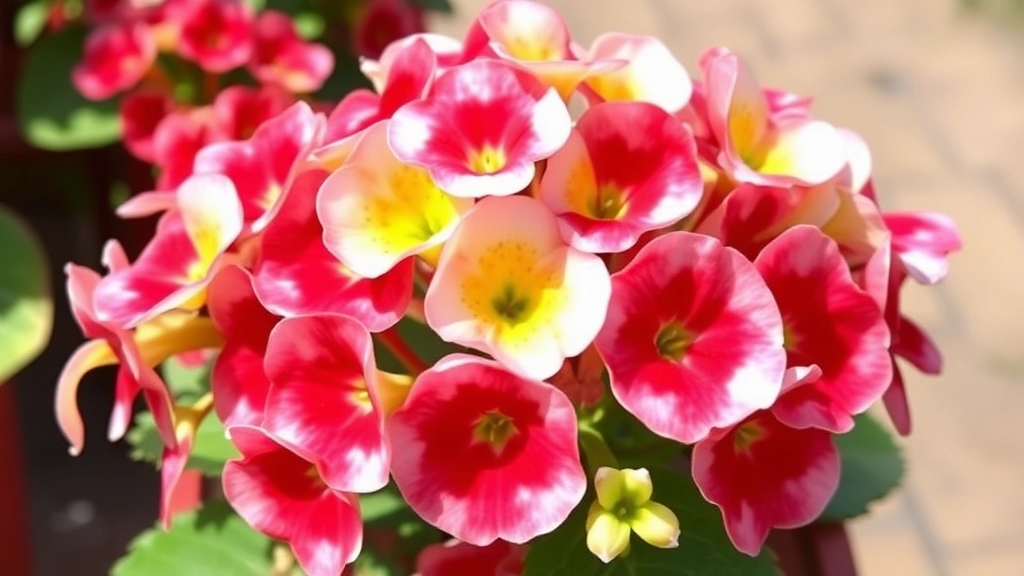Identifying Issues with Kalanchoe Leaves
Have you noticed white spots on your Kalanchoe leaves? These spots are often a sign of powdery mildew or pest infestations. Powdery mildew is a common fungal disease in succulents, especially in humid environments. Alternatively, mealybugs might be the culprits, leaving behind cotton-like white spots. Identifying the cause is the first step to restoring your plant’s health.
Treatment for Powdery Mildew
If you’re dealing with powdery mildew, treating it promptly is crucial. Home remedies like neem oil or baking soda solutions can be effective.
Pest Control Options
For pest infestations, consider using insecticidal soap or rubbing alcohol to remove mealybugs.
Preventive Measures
Proper watering and maintaining a well-ventilated environment can help prevent these issues from reoccurring. Keep your Kalanchoe healthy by addressing these white spots early on.
Common Causes of White Spots on Kalanchoe Leaves
Have you noticed unsightly white spots on your Kalanchoe leaves? You’re not alone in your concern. Understanding the common causes behind these blemishes is crucial for maintaining the health of your plant.
1. Powdery Mildew
One of the most frequent culprits is powdery mildew, a fungal disease that presents as white, powdery patches on leaves. It thrives in humid conditions and can spread rapidly if not addressed.
2. Pest Infestation
Another common cause is pest infestations, particularly mealybugs and spider mites. These pests can leave white spots and webs on your plant, damaging its overall health. For more information on how to manage these pests, check out our complete care guide for Kalanchoe succulents.
3. Environmental Stressors
Environmental factors such as inconsistent watering, poor air circulation, and excessive humidity can also lead to white spots. Stress can weaken your Kalanchoe, making it more susceptible to diseases and pests. Learn how to optimize your plant’s environment with our optimal watering tips for healthy Kalanchoe.
4. Nutrient Deficiencies
Sometimes, white spots can indicate nutrient deficiencies, particularly a lack of calcium or magnesium. This can affect leaf health and lead to discoloration.
5. Sunburn
Direct sunlight can scorch the leaves, resulting in white or bleached patches. It’s essential to monitor light exposure to prevent this.
Identifying Powdery Mildew on Kalanchoe

Have you noticed some white, powdery spots on your Kalanchoe leaves? You’re not alone! Many plant lovers face this issue, and it can be quite concerning.
Powdery mildew is a common fungal disease that thrives in warm, dry conditions. Here’s how to identify it:
- White, Powdery Coating: The most obvious sign is a white, talcum-like substance on the leaves. It can spread quickly if not addressed.
- Leaf Discoloration: As the infection progresses, you might see yellowing or browning of the leaves. This can lead to wilting or dropping leaves altogether.
- Stunted Growth: If your Kalanchoe seems to be growing slower than usual, powdery mildew could be the culprit.
- Position of Spots: Check the undersides of leaves too. The mildew often starts there before spreading to the top.
How to Treat Powdery Mildew on Kalanchoe
If you’ve identified powdery mildew on your Kalanchoe, you’re likely wondering how to address this frustrating issue effectively.
Immediate Actions
- Isolate Affected Plants
To prevent the spread of mildew, move affected plants away from healthy ones. - Prune Infected Leaves
Use sterilised scissors to remove any leaves showing signs of powdery mildew. This helps reduce the fungal load. - Increase Air Circulation
Ensure your Kalanchoe is not overcrowded. Good airflow can significantly reduce humidity, which is conducive to mildew growth.
Treatment Solutions
- Homemade Remedies
- Baking Soda Spray: Mix 1 tablespoon of baking soda with 1 litre of water. Spray this solution on the affected areas. This helps to neutralise the fungus.
- Milk Spray: A mixture of 1 part milk to 9 parts water can also be effective. Spray it on the leaves, as the enzymes in milk can combat the mildew.
- Commercial Fungicides
Look for fungicides specifically designed for powdery mildew. Follow the instructions on the label for best results. - Natural Solutions
Neem oil is a popular choice. Dilute according to the instructions and apply it to the leaves. This not only treats mildew but also repels pests.
Preventive Measures
- Regularly inspect your Kalanchoe for early signs of mildew.
- Maintain proper watering practices to avoid excess moisture, which can lead to fungal issues.
Additional Resources
For more detailed care tips, check out our Kalanchoe Red Lips Care Guide and our Mother of Millions Care Guide.
Common Pests That Cause White Spots on Kalanchoe
As we explore the various reasons behind the white spots on Kalanchoe leaves, it’s essential to consider the role of pests.
Many plant enthusiasts worry about pests, as they can wreak havoc on your beloved Kalanchoe. Here are some common pests that can lead to those unsightly white spots:
- Mealybugs: These small, white, cotton-like insects often cluster in leaf axils and on stems. They suck the sap from the plant, leading to a weakened plant and potential white spots.
- Spider Mites: These tiny arachnids can be difficult to spot without a magnifying glass. They create fine webs and can cause stippling on leaves, resulting in discolouration.
- Scale Insects: Scale appears as small, rounded bumps on the leaves or stems. They also feed on the plant’s sap, leading to stress and potential white spots.
- Whiteflies: These small, flying insects can be found on the undersides of leaves. Their feeding can cause leaf yellowing and white spots as they excrete honeydew, which can lead to sooty mould.
Identifying these pests early is crucial for effective treatment.
Removing Mealybugs and Other Pests from Kalanchoe
Dealing with pests like mealybugs can be a frustrating experience for Kalanchoe enthusiasts.
Have you noticed white, cotton-like clusters on your Kalanchoe leaves?
These could very well be mealybugs, which not only mar the beauty of your plant but can also lead to further health issues.
Here’s how to effectively remove mealybugs and other pests from your beloved Kalanchoe:
Identifying Mealybugs
- Look for white, fuzzy patches on leaves and stems.
- Check the undersides of leaves, as mealybugs often hide there.
- You may also notice a sticky residue, known as honeydew, which can attract ants.
Removal Steps
- Manual Removal:
- Use a cotton swab dipped in rubbing alcohol to gently wipe the mealybugs off the leaves.
- For larger infestations, you may need to prune affected leaves.
- Soap Solution:
- Mix a few drops of mild dish soap with water in a spray bottle.
- Spray directly on the affected areas.
- Leave it for a few hours before rinsing off with clean water.
- Neem Oil Spray:
- Neem oil is a natural pesticide that can help eliminate mealybugs.
- Mix neem oil with water according to the instructions on the bottle.
- Spray on the plant, ensuring you cover all surfaces.
- Insecticidal Soap:
- If the infestation is severe, consider using a commercial insecticidal soap.
- Follow the instructions on the label for application.
- Quarantine Affected Plants:
- If you have multiple plants, isolate the infested Kalanchoe to prevent the spread of mealybugs.
Prevention Tips
- Regularly inspect your plants for early signs of pests.
- Maintain good air circulation around your Kalanchoe.
- Avoid overwatering, as damp conditions can attract pests.
For more detailed care tips, check out our Care Guide for Yellow Florist Kalanchoe Blossfeldiana and learn about the Key Features of Different Kalanchoe Species.
Effective Home Remedies for White Spots on Kalanchoe

So, you’ve spotted those pesky white spots on your Kalanchoe, and you’re probably wondering how to tackle them without breaking the bank.
Don’t worry; there are some effective home remedies that can help you get your plant back to its vibrant self.
Here’s a quick rundown of what you can try:
- Baking Soda Solution: Mix 1 tablespoon of baking soda with 1 gallon of water. Spray this mixture on the affected leaves. It helps combat powdery mildew and is super easy to whip up.
- Neem Oil: This natural insecticide works wonders against pests like mealybugs. Mix it with water as per the instructions on the bottle and spray it on your Kalanchoe.
- Soap and Water: A simple solution of mild dish soap and water can help remove pests. Just mix a few drops of soap with water and spray it on the leaves. Rinse it off after a few hours.
- Garlic Spray: Blend a few cloves of garlic with water, strain it, and use the liquid as a spray. Garlic is a natural pest repellent!
- Milk Spray: A mix of 1 part milk to 9 parts water can help treat powdery mildew. Spray it on the leaves and let it dry in the sun.
These remedies are not only effective but also eco-friendly, making them perfect for the plant lover who wants to keep their garden green and clean.
Remember, while these home remedies can be effective, consistency is key. You may need to repeat the treatments every week until you see improvement.
### Importance of Proper Watering to Prevent Fungal Diseases
Have you ever noticed your Kalanchoe developing white spots and wondered if improper watering might be to blame?
Watering is a crucial aspect of plant care, especially for Kalanchoe, which thrives in well-drained conditions.
Here’s why proper watering is essential:
Environmental Factors Contributing to Fungal Growth

Ever noticed those pesky white spots on your Kalanchoe and wondered what’s causing them? Sometimes, the environment plays a significant role in fostering fungal growth.
Here are some key factors to keep in mind:
- Humidity Levels: High humidity can create a perfect breeding ground for fungi. If your home is humid, it might be time to invest in a dehumidifier or place your Kalanchoe in a drier spot.
- Poor Air Circulation: Stagnant air can trap moisture around your plants. Ensure your Kalanchoe has enough space and isn’t crowded by other plants.
- Temperature Fluctuations: Extreme temperature changes can stress your plant and make it more susceptible to diseases. Try to keep your Kalanchoe in a stable environment, ideally between 18-24°C (65-75°F).
- Overwatering: This is a biggie! Consistently soggy soil can lead to root rot and fungal issues. Always check the soil moisture before watering.
- Dirty Pots and Tools: Sometimes, it’s the little things that make a big difference. Make sure your pots and gardening tools are clean to avoid introducing fungi to your plants.
By keeping an eye on these environmental factors, you can significantly reduce the chances of fungal growth on your Kalanchoe.
Preventing Future White Spots on Kalanchoe Plants
Are you tired of battling those pesky white spots on your Kalanchoe leaves?
Understanding how to prevent these issues is just as important as treating them.
Here are some effective strategies to keep your Kalanchoe healthy and vibrant:
1. Optimal Watering Practices
- Water Early: Water your Kalanchoe in the morning to allow excess moisture to evaporate throughout the day.
- Avoid Overwatering: Ensure the soil dries out between waterings to prevent fungal growth. For more detailed tips, check out our Optimal Watering Tips for Healthy Florist Kalanchoe.
2. Improve Air Circulation
- Space Plants: Ensure your Kalanchoe has enough space between other plants to allow for proper airflow.
- Use Fans: If indoors, consider using a small fan to enhance air circulation.
3. Maintain Proper Humidity Levels
- Monitor Humidity: Kalanchoe prefers moderate humidity. Use a hygrometer to keep track.
- Avoid Excess Moisture: Keep plants away from overly humid areas, such as bathrooms.
4. Regular Inspection
- Check Leaves Frequently: Inspect your plants weekly for any signs of pests or mildew.
- Remove Affected Leaves: If you spot any white spots, remove the affected leaves promptly. For a comprehensive guide, refer to our article on Why Are My Kalanchoe Leaves Dying: Causes & Solutions.
5. Choose the Right Location
- Bright, Indirect Light: Place your Kalanchoe in a spot that receives bright, indirect sunlight to discourage fungal growth.
- Avoid Direct Sunlight: Too much direct sunlight can stress the plant, making it more susceptible to diseases.
6. Use Quality Soil
- Well-Draining Soil: Opt for a potting mix designed for succulents to promote drainage.
- Refresh Soil Annually: Consider repotting your Kalanchoe annually to ensure it has fresh, nutrient-rich soil.
7. Fertilize Wisely
- Balanced Fertilizer: Use a balanced, diluted fertilizer during the growing season to provide essential nutrients.
- Limit Fertilization: Avoid over-fertilizing, as this can lead to weak, disease-prone plants.
Best Fungicides and Insecticides for Treating Kalanchoe

So, you’ve spotted those pesky white spots on your Kalanchoe, and you’re probably wondering what to do next.
Choosing the right fungicides and insecticides can make all the difference in keeping your plant healthy and vibrant.
Fungicides for Powdery Mildew:
- Neem Oil:
- A natural option that works wonders.
- Just mix it with water and spray it on the affected leaves.
- Not only does it tackle mildew, but it also helps with pests.
- Sulfur-Based Fungicides:
- Great for preventing and treating powdery mildew.
- Apply it in the early morning or late evening to avoid harming your plant.
- Potassium Bicarbonate:
- Another effective treatment that disrupts the mildew’s growth.
- Mix with water and spray directly on the leaves.
Insecticides for Pests:
- Insecticidal Soap:
- Perfect for mealybugs and aphids.
- Just spray it directly on the bugs; they can’t stand it!
- Pyrethrin:
- A natural insecticide derived from chrysanthemum flowers.
- Highly effective against a range of pests.
- Horticultural Oil:
- Works well against both pests and fungal diseases.
- Just remember to apply it when temperatures are cooler to avoid stressing your plant.
Application Tips:
- Always read the label for dosage and application frequency.
- Test on a small area first to ensure your Kalanchoe doesn’t react badly.
- Apply in the evening to reduce the risk of leaf burn.
By using the right products, you can effectively combat those white spots and keep your Kalanchoe thriving.
How to Maintain Healthy Kalanchoe Plants Long-Term
Maintaining the health of your Kalanchoe plants is essential to ensure they thrive and remain free from white spots and other issues. You may be wondering, “What are the best practices for keeping my Kalanchoe healthy?”
FAQs on Kalanchoe White Spots
What causes white spots on Kalanchoe leaves?
White spots on Kalanchoe leaves are often caused by powdery mildew, a fungal disease that thrives in warm, dry conditions. Pests like mealybugs, spider mites, scale insects, and whiteflies can also lead to white spots.
How can I identify powdery mildew on my Kalanchoe?
Powdery mildew appears as a white, powdery coating on the leaves. It may also cause leaf discoloration, stunted growth, and spots on the undersides of leaves.
What are some effective home remedies for treating white spots on Kalanchoe?
Home remedies include baking soda solution, neem oil, soap and water, garlic spray, and milk spray. These remedies are eco-friendly and can effectively tackle both fungal and pest issues.
How do environmental factors contribute to fungal growth on Kalanchoe?
High humidity, poor air circulation, temperature fluctuations, overwatering, and dirty pots and tools can create conditions favorable for fungal growth. Managing these factors can help prevent fungal issues.
What pests should I look out for on my Kalanchoe?
Common pests include mealybugs, spider mites, scale insects, and whiteflies. These pests can cause white spots and other damage to your Kalanchoe by feeding on its sap.
What are the best fungicides for treating powdery mildew on Kalanchoe?
Effective fungicides include neem oil, sulfur-based fungicides, and potassium bicarbonate. These products can help prevent and treat powdery mildew when applied correctly.
Which insecticides are effective against pests on Kalanchoe?
Insecticidal soap, pyrethrin, and horticultural oil are effective against pests like mealybugs and aphids. These insecticides can help keep your Kalanchoe pest-free.
How should I apply fungicides and insecticides to my Kalanchoe?
Always read the label for dosage and application frequency. Test on a small area first to ensure your Kalanchoe doesn’t react badly. Apply in the evening to reduce the risk of leaf burn.
Can overwatering cause white spots on Kalanchoe?
Yes, overwatering can lead to fungal issues, including powdery mildew, which can cause white spots. Always check soil moisture before watering your Kalanchoe.
How often should I repeat home remedies for white spots on Kalanchoe?
Consistency is key. You may need to repeat treatments every week until you see improvement. Regular monitoring and treatment can help keep your Kalanchoe healthy.
References
-
Gardening Know How: Kalanchoe Powdery Mildew
-
The Spruce: Kalanchoe Pests and Diseases
-
The Old Farmer’s Almanac: Mealybugs
